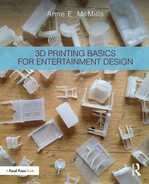Foreword
As I sit here writing at a borrowed desk, three little Chippendale chairs are scattered under the screen. They seem to be in 1/4” scale, but I know enough to know they might be in most any scale. The fact that they are absolutely identical is no longer noteworthy to me, nor is their existence – casually discarded as they are – especially remarkable. All of which goes to show just how remarkable 3D printing is.
As supposedly “mainstream” or “old school” a designer I might be labeled, I was astonished to find upon examining the production of The Nance, which I designed for Broadway at the Lyceum Theater, that whatever looked the most hand-painted was actually computer-painted and that which might have looked mechanically crafted was actually handmade; the computerized cutting table and the Vacuform machine worked in tandem with computer-executed material inspired by my handwork to create what looked like “handwork.” Oddly, these modern tools made the scenery and props more honestly a reflection of my personal hand, revealing more of me and less of the shadows of multiple and inconsistent human interpretations. Accustomed as we are to calling crafted theater objects the last of the truly “handmade” items, it seems to be time to redefine the term “handmade.”
3D printing has allowed one to “build” from a drawing, not allowing the difficulty of miniaturization (or in some cases, full-size creation) of hand designing to interfere with the original style impulse. A Chippendale chair emerges intact with little glue-and-cardboard interference – and, in fact, can emerge identically and in profusion as long as required. So, too, can full stage model pieces be repeated identically without frustration, huge effort, or late-night panic. 3D printing allows one to finish a designer’s work more clearly and removes one layer between “large” and “small” design inspiration and its accurate structural realization. And not just from large design to small and then onstage to large again; in reality, soon the 3D printer will be producing larger and larger components of scenic expression. And some pretty nifty props too.
This new tool, much like the computerized painting machines and the computerized cutting table, may lay more – not less – responsibility on the designer’s own hand. The realization of a painting, a furniture design, a model of a piece of scenery, or even an actual piece of scenery has less “interference.” One is returned to the original charge of design: What does it look like? How big is it? What details of style does it possess? Is it a feasible construction? And, as a three-dimensional object, is it coherent from all viewing angles?
Some 3D printing can be a diagnostic of design – for instance: “Print it out and see what it looks like,” or “Do the corners actually meet?” One of my favorite moments working with Kacie Hultgren, who had set up printed versions of one of my designs, was when she said, “Let me print your forced perspective farmhouse, and you can actually see what you drew.” You can actually see what you drew! No wishful thinking or bending of Bristol board … “You can actually see what you drew.” Remarkable.
And getting back to those Chippendale chairs.… On a personal note, I must say my greatest thrill from the 3D printer is that I can ask for 73 Chippendale chairs and no assistant will groan; the chairs will all look exactly the same, the director and I can see what a pile of 73 Chippendale chairs would look like, and we can decide to go another way with no blood, sweat, or tears. And those same Chippendale chairs might be lying in wait on someone else’s desk someday – scattered underneath the screen – quietly existing in their remarkable, unremarkable existence.
John Lee Beatty
Broadway scenic designer
